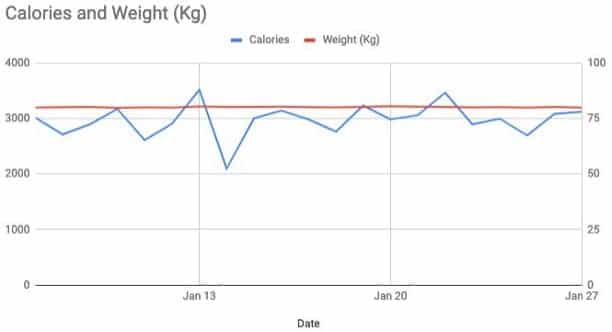- How Much Weight Can You Realistically Lose in 3 Months? - January 14, 2024
- How To Lose 1kg a Week (Guaranteed) - August 20, 2023
- How To Count Calories (or Estimate) and Stay on Track When Eating Out at Restaurants - July 25, 2023
The key to effectively managing your body composition (the ratio of fat to muscle you have) comes from knowing roughly how many calories you need to eat to either lose weight or build muscle.
The gateway to finding this number is through knowing roughly what your maintenance calories are.
WHAT ARE MAINTENANCE CALORIES?
Your maintenance calories, are the average number of calories you burn in a day. If you ate the same number of calories as this, you’d maintenance your weight, hence; maintenance calories.
Once you’re aware of this number, you can either adjust down (for weight loss), or up (for muscle gain).
There are a few different ways to calculate your maintenance calories, some take a bit less time, but are less accurate, whereas the method that takes the most time will be the most accurate.
Caveat: None of these methods are 100% accurate, but it doesn’t matter. The important thing is that you have a rough baseline to work from.
Here goes;
METHOD 1: USE MY FREE MAINTENANCE CALORIE CALCULATOR
This is the quickest and easiest method, but not necessarily the most accurate. There are other ways to calculate your maintenance calories manually with a calculator, or by using your own real-world data (if you have it)…
METHOD 2: THE HARIS-BENEDICT EQUATION
- Go to this URL: https://manytools.org/handy/bmr-calculator/
- Enter your details
- Get Your Results (I’ve pasted mine below)
Use the bottom number (Daily Calorie Needs) is the one you want.
So, 2,700 burned per day on average
The Top number is your BMR (i.e. your metabolic rate), this is the number of calories you’d burn if you laid down all day doing nothing (this is only affected by your weight, height, gender, and age, therefore there’s not much you can do to change it).
When you enter your activity level, don’t stress too much about which one describes you best, just pick one that closely matches your activity level and go from there, remember, this is just a start point, we’ll learn more about our true maintenance when we start tracking weight, calories, and activity
METHOD 3: DATA EXTRACTION FROM ACTIVITY TRACKER
Most activity trackers will use your heart rate to estimate how many calories you burn.
They will generally estimate your daily calorie burn, and in order to get your maintenance calories from this, you should take an average across as long a period of time as possible. I’d recommend a minimum of 2 weeks.
Here, I have my FitBit data from the past rolling month (I’ve taken this from the FitBit desktop dashboard, but taking from the mobile app is just as good).
What this data tells me, is that, from 28th Feb-27th March, I’ve burned 82,313 calories.
All I need to do is divide this by the number of days to get my average daily calorie burn.
This is 26 days, so;
82,313/26 = 3165 calories burned per day on average
Why is this so much higher than the previous figure of 2700 spat out by the Harris-Benedict equation?
It’s probably simply down to the fact that I grossly underestimated my activity level using the Harris-Benedict method.
Don’t worry about this, after we’ve looked at the 3rd method, we’ll choose one method to go with, or take an average of the 3.
METHOD 4: TRACK CALORIES AND ACTIVITY FOR 2 WEEKS
This is the most time-consuming, but also arguably the most accurate (but still not 100% accurate) method.
What you’ll need to do is track your weight and calories for a period of time. The longer you do it, the more accurate results you’ll get, but again I’d recommend a minimum of 2 weeks.
This will tell you how the volume of calories you eat directly affects your weight.
Caveat: There are other things that affect your weight, such as the amount of water you’ve drunk recently and the amount of food in your gut – so weight loss or gain doesn’t necessarily equal fat loss or gain, but long term weight gain or weight loss is a good barometer as to whether you’ve gained or lost fat
So, eat as you normally would but track all your calories in My Fitness Pal, or another similar app every day.
Also, track your weight every day. Do this at the same time of day (preferably first thing in the morning, before eating or drinking anything, and after going to the toilet), every day. You can do this either on paper, on the Notepad on your phone, or preferably within My Fitness Pal.
Once your tracking period is up, you’ll divide the total amount of calories you ate to get a daily average.
You’ll then look at your start weight and finish weight.
If it’s increased you can be fairly certain you were in a calorie surplus, if it decreased you can be fairly certain you were in a calorie deficit, if it stayed the same, you were at maintenance.
Here’s how maintenance might look;
And here’s the hypothetical daily weight and calorie measurements
| Date | Jan 7 | Jan 8 | Jan 9 | Jan 10 | Jan 11 | Jan 12 | Jan 13 |
| Calories | 3018 | 2717 | 2900 | 3176 | 2614 | 2909 | 3520 |
| Weight (Kg) | 80 | 80.2 | 80.3 | 79.9 | 80.1 | 80 | 80.5 |
| Jan 14 | Jan 15 | Jan 16 | Jan 17 | Jan 18 | Jan 19 | Jan 20 |
| 2100 | 3008 | 3146 | 2988 | 2765 | 3237 | 2989 |
| 80.3 | 80.3 | 80.4 | 80.2 | 80.1 | 80.3 | 80.6 |
| Jan 21 | Jan 22 | Jan 23 | Jan 24 | Jan 25 | Jan 26 | Jan 27 |
| 3065 | 3470 | 2899 | 3001 | 2699 | 3089 | 3127 |
| 80.4 | 80.3 | 80.1 | 80.2 | 80 | 80.3 | 80 |
To calculate the average amount of calories you ate each day, simply add up the calories you ate each day and divide by the total number of days you tracked for.
In this case, the average is 2,973.
If your starting weight and finishing weight are the same, this means you were eating at calorie maintenance for the period you tracked.
In this case, we can be confident that the calorie maintenance was 2,973.
If over the period your weight has increased, you can be confident you are eating above maintenance calories, if your weight has decreased, you can be confident you were eating below maintenance calories.
WHAT NEXT?
Once you have a good idea of your maintenance calories, you can then make an informed decision on how many calories to eat based on your goal, whether that’s weight loss, muscle gain, or sports performance.
Of course, your maintenance is not static and will change over time based on your activity level and weight.
For this reason, you should consistently track your weight, calories and activity to ensure that you are on track with your goal. If you veer off course, you will have the data to analyse why, and you can make adjustments to get you back on track.
If you need any further help with losing weight or building muscle, get in touch.





Leave a Reply